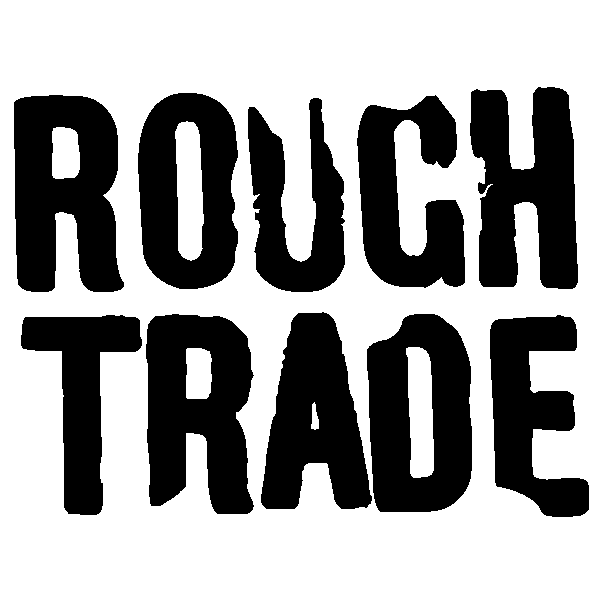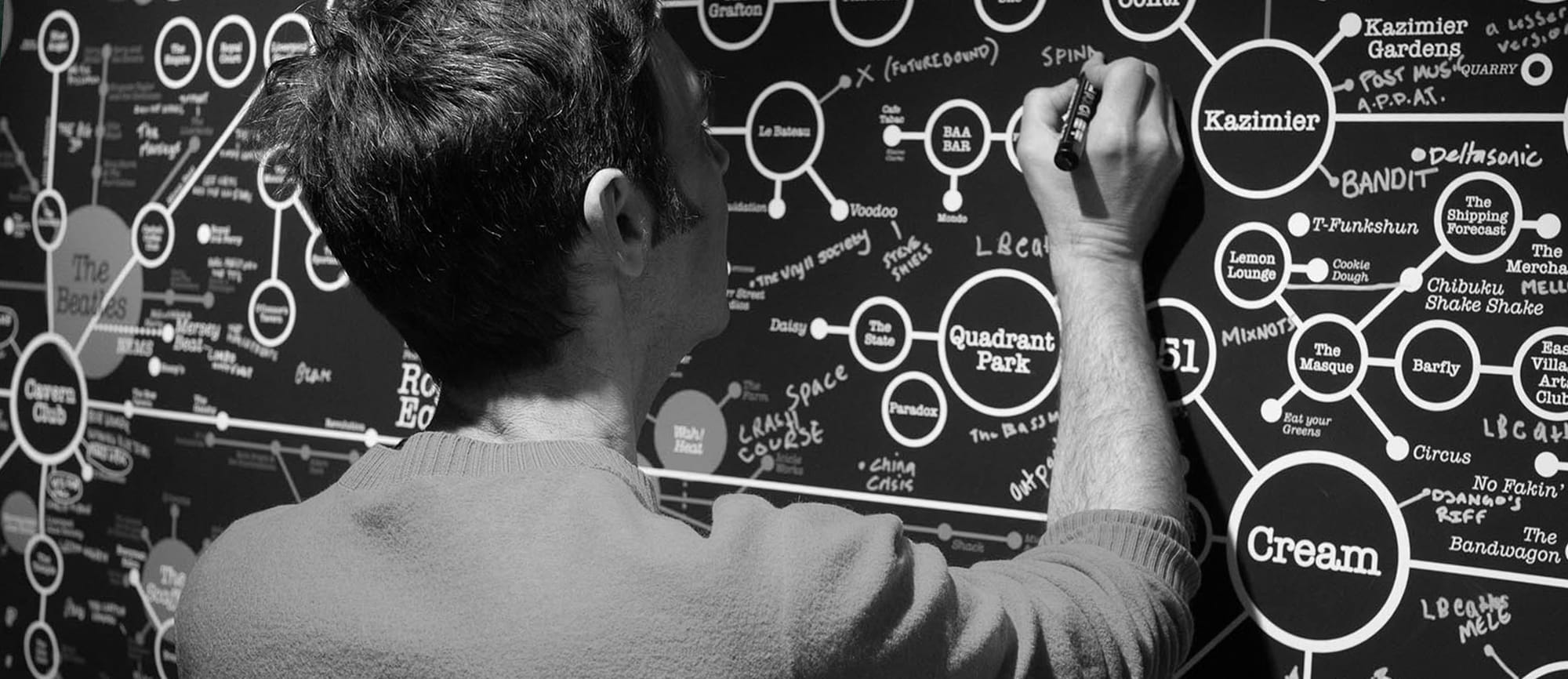"The Scene Here: Liverpool print is a vital piece of research and graphic ingenuity that documents the labyrinthine nature of the city’s musical developments. I hope that it also serves as inspiration for today’s musicians, venues, writers, filmmakers, bloggers and fans."
- Bryan Biggs, Director of Cultural Legacies at the Bluecoat
With an estimated 500+ music venues running across its 43 square miles, Liverpool is indisputably a city with live music at its beating heart. From the 60s Merseybeat era, where the city's most famous musical exports (The Beatles) cut their teeth in the Cavern Club, the legendary Eric's, breaking post-punk risers in the 80s (Echo and The Bunnymen played their infamous first concert as a three-piece with a drum machine in 1979) or the many nightclubs pushing forward an explosion of dance music shaping Liverpool's nightlife in the 90s (Creams, Voodoo and Quadrant Park). The same creative ethic which established Liverpool as a world-famous musical city between the 60s and 90s is present today, with an array of artists, producers and event promoters working hard in the city to provide unique and special live experiences. It has been a real pleasure to establish our own live venue space at Rough Trade Liverpool, where we have been lucky enough to host sold-out shows with Black Country New Road, Jake Bugg, Matt Berry, The Darkness, Paris Paloma and more.
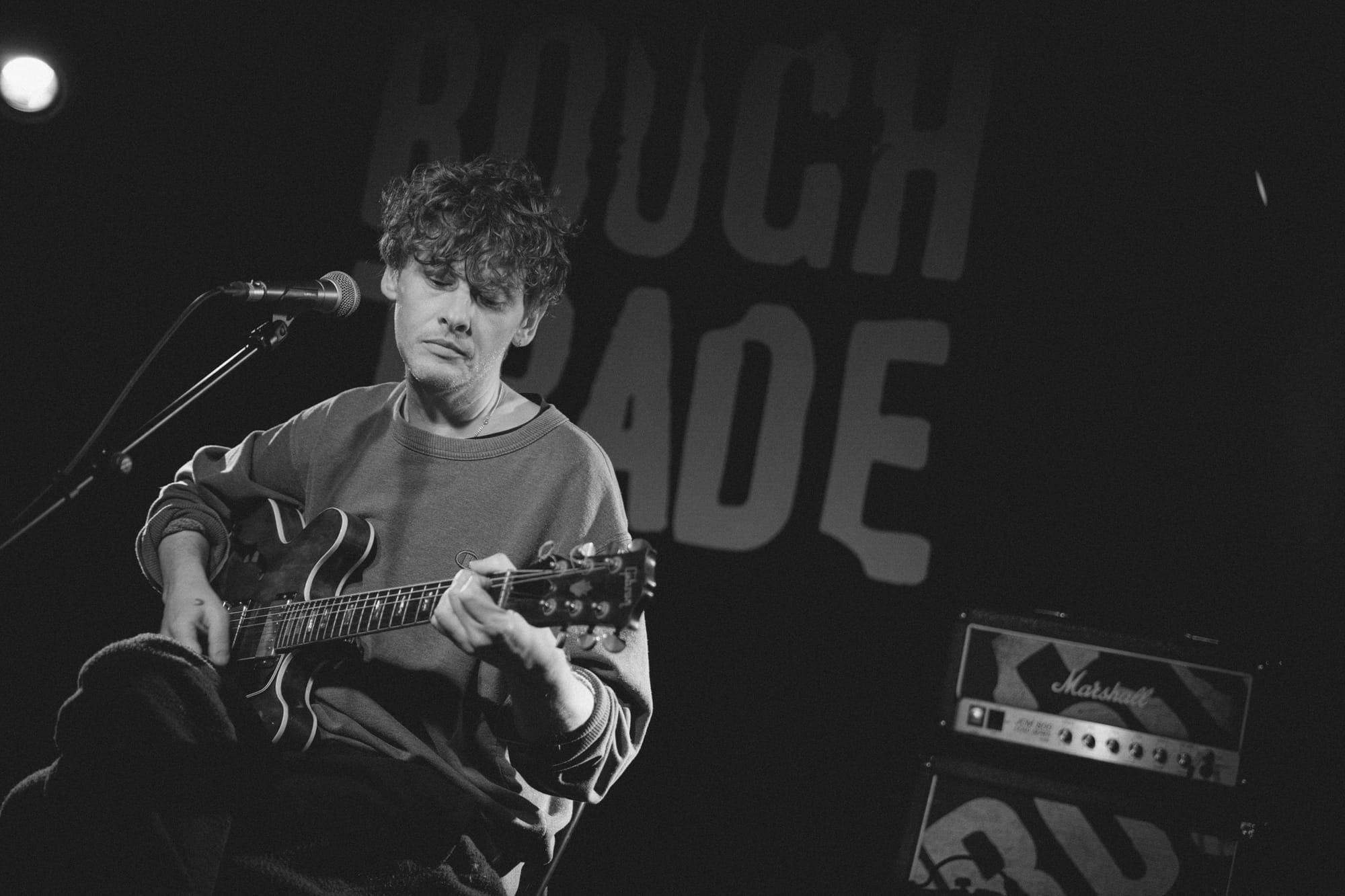
To celebrate Rough Trade joining the neighbourhood in April 2024, our good friends at Dorothy created Scene Here: Liverpool, a unique art piece displayed at Rough Trade Liverpool upon opening, mapping out the history of the city’s music scene from the 1950s to the present day. As part of this collaboration, we invited visitors to the store to contribute to a feature wall of suggestions to add to the artwork, showcasing the clubs and venues which helped or continue to make Liverpool one of the most musically creative cities in the world.
In 2025, we celebrate our own small part in Liverpool's music history, marking one year of Rough Trade Liverpool being open - the live music space celebrating 182 live shows and counting. As part of our celebrations, we revisit the impressive Scene Here artwork, reflecting with Dorothy and some of the key names within the map, the significance of the project.
A project like Scene Here reminds us of the ongoing mission to secure and protect grassroots venues, as this vital sector continues to be threatened by decline. Particularly pertinent to our Liverpool community is the 2023 study by music tech company A2D2, which analysed data from the Small Music Venues Index and Music Venue Trust to discover that grassroots music venues in England's North West region suffered the most. It’s crucial more than ever to continue supporting these venues and as the memories and reflections on Scene Here demonstrate, these spaces are the lifeblood of the UK music scene.
"As Rough Trade Liverpool marks its first year, it’s been amazing to see people from all walks of life coming through the doors - a real reflection of the city’s welcoming spirit and love for music. It’s also been refreshing to see so much new and emerging talent across Merseyside, showing just how exciting the local scene is. Most of all, having a space to host community events and give back to Liverpool’s creative community has been a real privilege, and we can’t wait to keep building on that."
Evan Tate, Events Manager, Rough Trade Liverpool
READ NOW: Liverpool in 20 Songs
Zanzibar, Eric's, The Cavern Club, Bluecoat, Africa Oyé and more. We explore the musical history of Liverpool, told through the places and venues where people have come together to experience music.
Jim Quail, Creative Director, Dorothy

"I wanted to create a piece that allows people to add their own experiences, and so that they can just read a name or a word and be mentally transported back to the time that they were there."
Featuring over 500 clubs, bands, musicians, festivals, record stores and record labels, Scene Here: Liverpool has been one of Dorothy's most complex mapping projects. How did you decide where to start with it, and how many people did you end up speaking with in your research?
Jim: It’s such an emotive subject, it seems everyone has a story or memory about something amazing that happened to them at a club or a venue, or an amazing place that they had been to but is now long gone.
I ended up chatting to nearly everyone I know or bumped into while I was working on it as it’s just a nice glimpse into their lives and it really helped to pull together a picture of the city through time and different generations and musical tastes. But I started with chatting to my parents and hearing their memories of places and bands and their experience of the area, then I reached out to members of iconic bands, to people who were there as audience members, to people behind the scenes from across different eras and genres and attempted to document their experiences. As you chat, you can see people being mentally transported back to some of the most important moments of their life, it’s like a time machine.
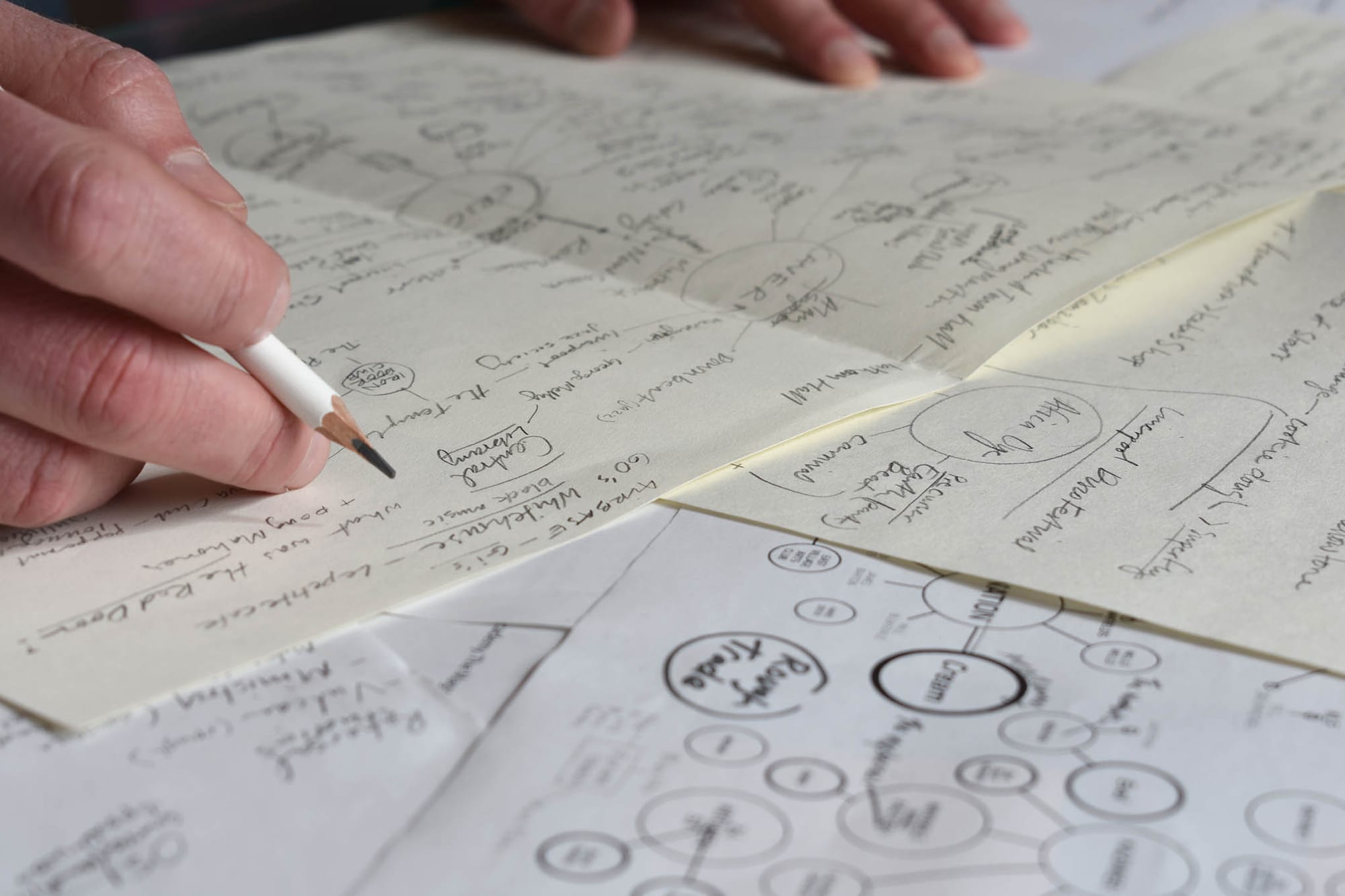
This helped further develop a rough skeleton of locations, which went up as a large format print installation in Rough Trade Liverpool, for people to be able to graffiti their contributions onto. After 3 months, the Rough Trade print installation was completely full of contributions, so we took it down, collected all the contributions and included them in a new version
What do you hope will be people's biggest takeaway will be from a project like this?
Jim: I wanted to celebrate and document those places that can be so important in people's lives, but can so often go forgotten about. I wanted to create a piece that allows people to add their own experiences, and so that they can just read a name or a word and be mentally transported back to the time that they were there.
Bryan Biggs, Director of Cultural Legacies at Liverpool’s contemporary arts centre the Bluecoat and former Liverpool College of Art student

"Many dismiss this level of obsession as simply unnecessary rock trivia, but I would argue that these painstaking labours of love make a hugely valuable contribution to our collective knowledge and understanding of this significant aspect of Liverpool’s cultural heritage."
The Deaf School emerged from Liverpool College of Art in the 1970s, alike to The Quarrymen, Liverpool College of Art's college band who later became the Beatles. The Scene Here: Liverpool print gives us a little demonstration of the art school-to-band relationship. How does the print also illustrate the role which the Bluecoat plays in Liverpool’s musical life?
Bryan: Liverpool Art School (then part of Liverpool Polytechnic) brought me to the city. I studied fine art in the main Hope Street building and at an annexe called the Deaf School, which provided the name for the large ramshackle ensemble that emerged - more of an art project than a music group initially. It quickly evolved into a decent gigging outfit with a highly visual stage presence and eclectic music styles that enlivened what was a pretty moribund local live music scene. Deaf School was the latest in a lineage of British pop groups with art school connections and, more than most, were a bona fide art school band, comprising nearly all either students or tutors at the college. They took their cue from Roxy Music and the Portsmouth Sinfonia and, in several ways, anticipated punk – cocking a snook at the rock establishment, band members adopting daft aliases, a DIY wardrobe, thrilling live gigs – but ultimately were swept away by it.
As a fellow student of some of the Deaf School, I did an early poster for them and have since curated a 40th anniversary exhibition at the current art school at Liverpool John Moores University. After graduating, I worked at the Bluecoat, Liverpool’s contemporary arts centre, running the gallery and devising programmes that dissolved the barriers between visual and performing arts. Building on an avant-garde history at the Bluecoat that included an event by Yoko Ono in 1967 and Captain Beefheart’s first ever painting exhibition in 1972, I was able to continue this creative interdisciplinary with commissions such as Live from The Vinyl Junkyard (1996), inviting artists to respond to the supposed death of vinyl with the advent of digital recording.
Our role has gone beyond simply putting on gigs by engaging with the popular (and less popular) music of the day in different ways, from possibly the first gallery exhibition of punk/new wave record sleeves, Cover Versions in 1981, featuring Malcolm Garrett, Peter Saville, Barney Bubbles and others, to hosting Taylor Swift’s moss-covered grand piano as part of the art trail accompanying her Liverpool visit last year.

How does recording history like this help us build ideas for protecting and growing Liverpool’s current musical landscape today?
Bryan: The Scene Here: Liverpool print is a vital piece of research and graphic ingenuity that documents the labyrinthine nature of the city’s musical developments. I hope that it also serves as inspiration for today’s musicians, venues, writers, filmmakers, bloggers and fans. At the Bluecoat, we commissioned Pete Frame to create a new series of his famous Rock Family Trees, focusing just on local bands, from Merseybeat to the Eric’s scene. The detail was fascinating, charting the legendary as well as the obscure and painting a compelling picture of pop music on Merseyside. Many dismiss this level of obsession as simply unnecessary rock trivia, but I would argue that these painstaking labours of love make a hugely valuable contribution to our collective knowledge and understanding of this significant aspect of Liverpool’s cultural heritage.
Favourite Liverpool musical memory?
Bryan: I have witnessed so many memorable gigs at the Bluecoat across a diversity of genres, including contemporary classical, early music, folk, jazz, indie, improvised, electronic, reggae, dub poetry, and partnerships with promoters bringing global perspectives to Liverpool - Africa Oyé, Liverpool Arab Arts Festival and MILAPfest. African American (by way of Saturn) jazz legend Sun Ra is probably the most fondly remembered gig – dressed in shimmering Afro-futurist robes, his Arkestra belted out nearly two hours of joyous cosmic music – the atmosphere akin to a rave. Organised by our live programmer Jayne Casey, this 1990 gig was recorded on shaky hand-held video, which is available on YouTube.
The Bluecoat has also promoted equally memorable performances off-site, notably future Turner Prize-winning artist Jeremy Deller’s Acid Brass at LIPA – the UK’s top brass band playing a night of acid house anthems, which we commissioned as part of our live art series Mixing It (1997). We were partners in bringing underground Leningrad collective Pop Mechanica to Liverpool to play their first post-Perestroika gig in this country at St George’s Hall in 1989, a crazy mash-up involving local musicians and artists and the experimental Russians, which culminated in the audience being pelted with raw sausages. From the ridiculous to the sublime, we restaged Pierre Henry’s Liverpool Mass at the Metropolitan Cathedral in 2017, fifty years after the French musique concrète composer and electronic music pioneer created this work for the opening of the cathedral. Jarvis Cocker introduced the evening, a haunting remix from the original tapes, performed by Henry’s collaborator, Thierry Balasse.
Girls Don't Sync, DJ Collective formed in Liverpool

"District will always be more than just a music venue, it’s been a cornerstone of fostering community and culture within Liverpool for years."
Girls Don't Sync are amongst 250 artists featured on the Scene Here print, alongside a variety of dance clubs which have shaped Liverpool's nightlife since the 90s. How does it feel to see yourselves imprinted as part of Liverpool's rich music heritage, and can you share how the city has shaped your journey so far?
Gaia: It feels very full circle to be included and part of the musical and cultural fabric that makes Liverpool feel so special and united. There’s always been a huge sense of togetherness, which we’ve felt since the beginning of our journey. Collaborating with other creatives and artists, teaming up with grassroots organisations and venues, etc, has been such an integral part of our growth, with so much genuine support at its core. We’ve also seen the rise of more collectives and initiatives coming through that have been so vital to the cities impact; the importance of radio and a hub for artists on Svara or Go Play, educational access through Decks in The City, NXT WAVE or events or venues with club culture at the forefront such as Chop Life and the Bakery. For us also, seeing a rise of upcoming SCOUSE female DJS take charge, like Amber Rose, Nay Maxwell, Gracie Grimes and Paige Tomlinson is everything. The community here and the way we celebrate and connect with each other has massively shaped our journey, and it’s something we will always treasure and continue to keep shouting about! Especially when it comes to the future of Liverpool’s night life and the people and places really cementing that right now.
Favourite memory at a Liverpool music venue?
Gaia: Our favourite memory has to be from our first proper event as Girls Don’t Sync at District. It was a day party vibe, sun was shining, RayRayz Caribbean on catering duties and we stacked a whole line up of upcoming female DJ’s within the city, for some of them it was their first time ever playing out, meant a lot to us to give them that opportunity and space. District is one of the only Black owned venues in Liverpool, and Eric Gooden the owner has truly supported us and our vision since the very start. District will always be more than just a music venue, it’s been a cornerstone of fostering community and culture within Liverpool for years. Without venues like this, the next generation of DJs, producers, and music lovers lose a vital place to connect and grow.
We need to fight more than ever to keep venues like District alive and open, it’s time our government prioritise and protect the nightlife sector and the many people behind it that are responsible for creating real impact and identities, which is something we will always be grateful for! Big up Eric!
SPINN, Liverpool-based four-piece

"Tony Butler was absolutely essential to developing the Liverpool scene when we were finding our feet, and gave us all a place where we were able to learn our craft and develop our artistry."
SPINN are amongst 250 bands featured on the Scene Here print, which features various contemporary Liverpool acts such as yourselves, The Mysterines, Bill Ryder Jones, Monks, Girls Don’t Sync and more. The project also pays homage to Liverpool pioneers such as Echo and The Bunnymen, Big In Japan and The La’s. How does it feel to see the band’s name on the print, in and amongst this wide reflection of the city’s impressive music history?
Johnny: It’s a great feeling to be featured on this print, we’re incredibly proud to be from Liverpool and always do our best to represent our city and its musical heritage in the best light wherever we go. There are some pretty big names on there, so to be listed amongst them is pretty surreal for us, but also feels really rewarding. We’ve worked so hard over the years within the indie pop genre, and it’s so nice to be recognised and included in something as cool as this.
This print has been an ongoing project, allowing Rough Trade Liverpool’s customers to contribute their own ideas of venues, bands and individuals which could feature on a future edition. Can you share any suggestions, featured or not featured on the print, that have played a significant role in the SPINN story?
Johnny: I’d like to mention firstly the band Echo Beach, who’ve long since split up, but they were pivotal for us when we started out, as they were one of the only other bands playing similar music to what we were at that time. Their friendship and guidance massively helped us build confidence in what we were doing at the time, and playing our early shows with them are some of my happiest memories of being in a band. Their track Athena is still one of my favourite indie tracks the city has produced. Secondly I’d like to mention Tony Butler, who ran the Zanzibar for many years. Unfortunately, he has since passed away, but he was the first promoter to ever take a chance on us, and a lot of other local bands. Tony Butler was absolutely essential to developing the Liverpool scene when we were finding our feet, and gave us all a place where we were able to learn our craft and develop our artistry. A great man. Rest in peace, Tony.
David McTague, Head of Marketing & Partnerships, Africa Oyé and promoter at Mellowtone Records
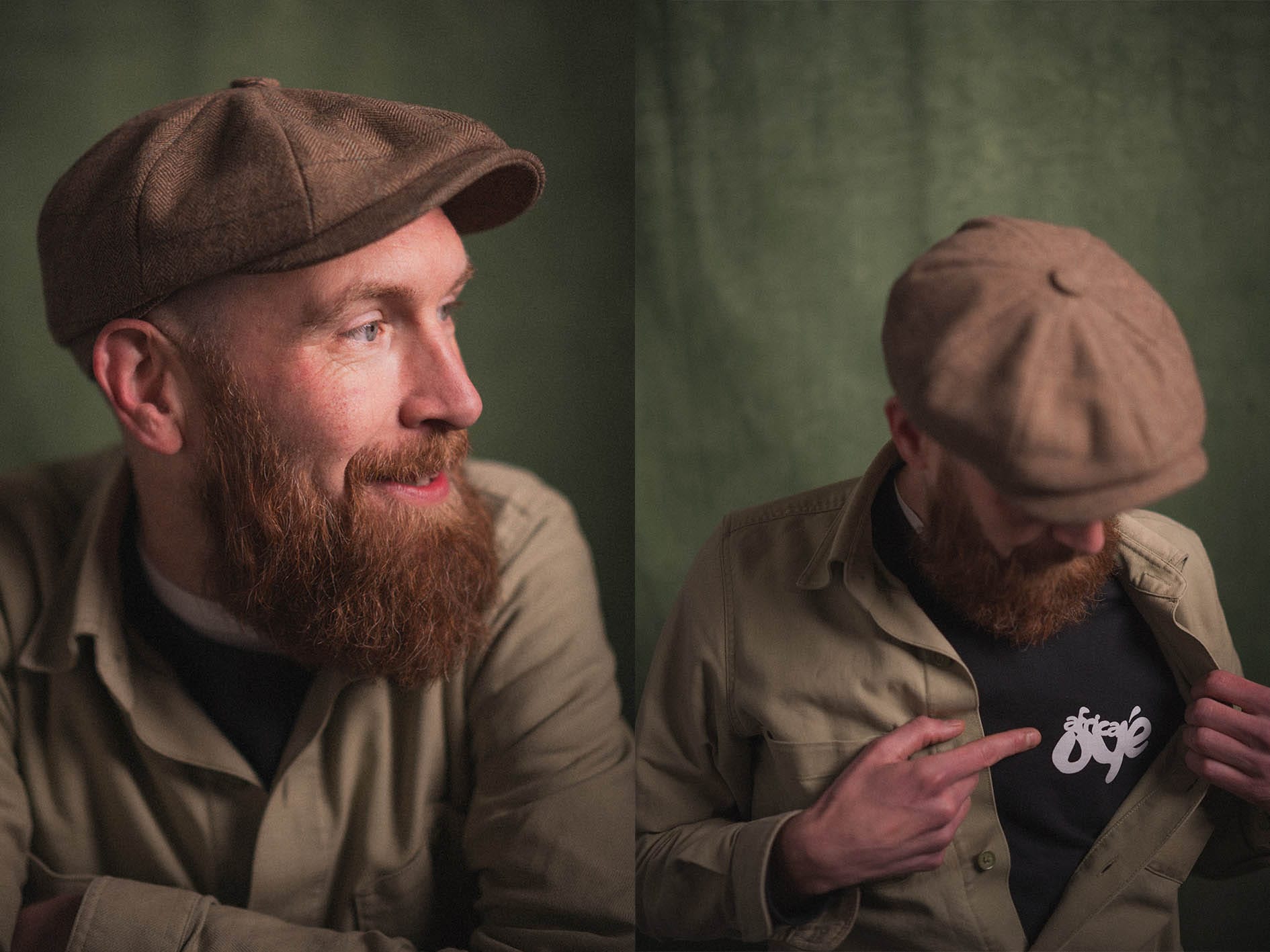
"The many L8 social clubs, blues and shebeens, as well as Liverpool's Carnival, are also precursors to Oyé, and very important parts of Liverpool's Black and cultural heritage."
Scene Here: Liverpool features Africa Oyé as a festival which has played just as much a part in shaping Liverpool as a world-famous destination for music as the various live music hubs and artists which also make up this print. How does it feel to see the festival acknowledged in this way over thirty years on from the festival’s first edition?
David: It's great to see Oyé included! And it's wonderful that Oyé takes place right here in Liverpool!
Africa Oyé is one of the largest celebrations of live African music and culture in the UK, born from a series of gigs across Liverpool City, booked by Glaswegian pirate radio broadcaster Kenny Murray. Are there any other clubs/venues/institutions on the Scene Here map which have had a role to play in Africa Oyé’s evolution from gigs to a festival, and are intertwined with its growing community?
David: Yes indeed, Oyé is the UK's largest celebration of African music and culture - last year we attracted 80k people to Sefton Park! As you mention, Oyé grew out of (well before my time!) a series of gigs and events in Liverpool at the Corinto Club at Hardman House, the Irish Centre and the Picket, with the likes of Jake Rooney, Vicky Doyle, Francisco Carrasco and more involved, and of course the drive and vision of Kenny Murray. Oye shows used to be held at places like the Magnet (RIP), Bluecoat, The Palm House, The Hope St Hotel, and even at Concert Square - when it was actually a square for concerts haha!
Notable mentions should also go to the likes of Kif Higgins and Earthbeat. Earthbeat was a festival in the 80s, and a precursor of sorts for Oyé happening in the park. Larks in the Park was another Sefton Park event, before Oyé's time... the lineage of alternative festivals in the park is there. You can check some amazing shots by Mark McNulty from these events. The many L8 social clubs, blues and shebeens, as well as Liverpool's Carnival, are also precursors to Oyé, and very important parts of Liverpool's Black and cultural heritage. And the gang at District - Jayne Casey and Eric - have been incredibly supportive of Oyé over the years, whether that be hosting artists at their venue for many years, or running the first bar on site. Paul Duhaney - Oye's current Artistic Director - joined the organisation in 1999, and worked under Kenny for a long time, and has since headed up the organisation for over a decade. More recently, Oyé has also partnered with many more of the organisations and venues featured on the map, including Positive Vibration, Mellowtone, Harvest Sun, 24 Kitchen St, No Fakin', The Tung Auditorium, Camp & Furnace, The Philharmonic Hall and Music Room. I've worked with Oyé for over 20 years myself now, so it's been quite the journey to see it grow and blossom into the wonderful celebration it is today.
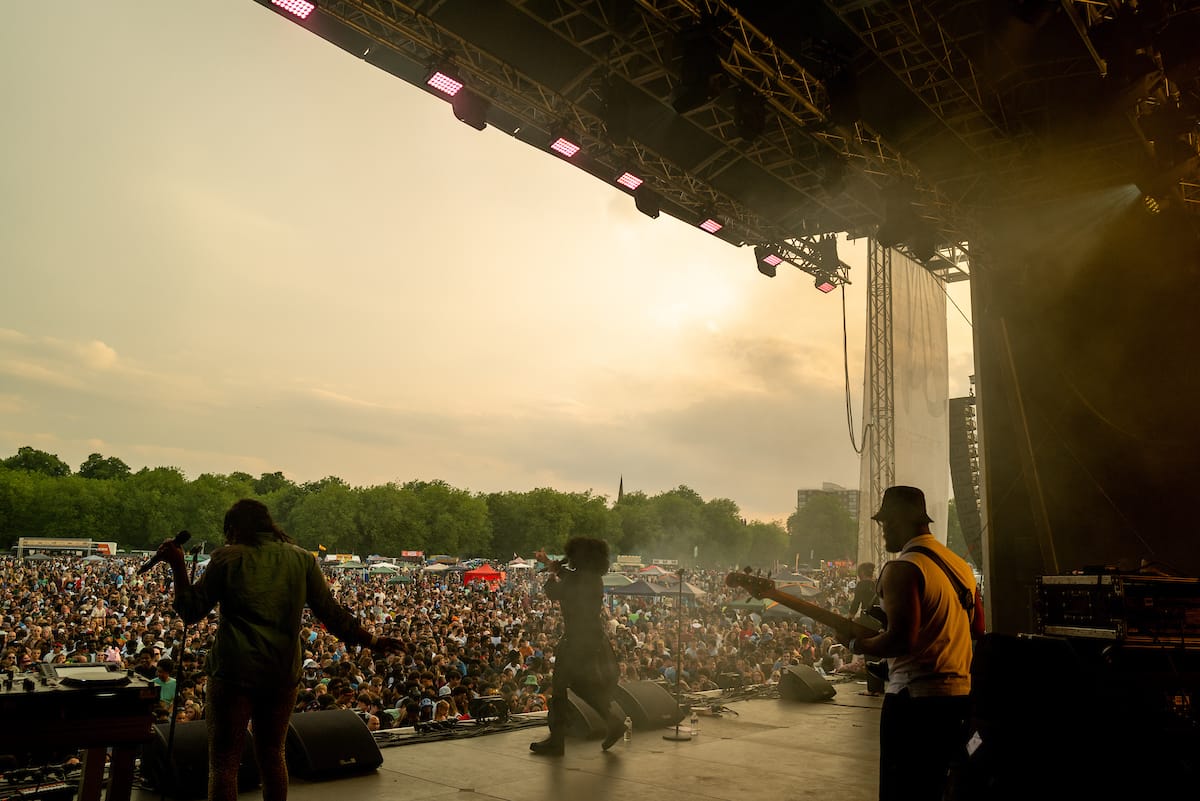
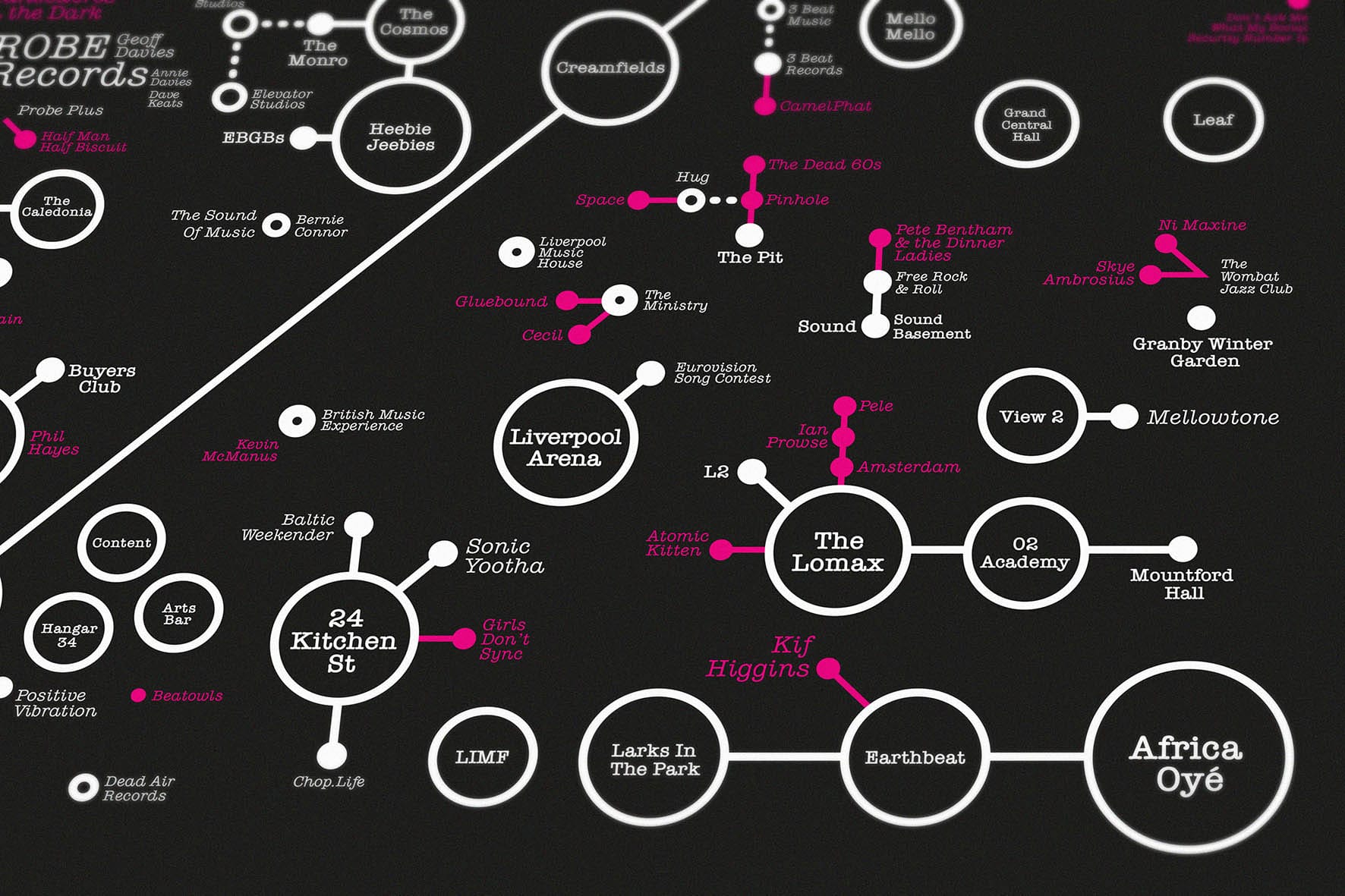
You also run the Mellowtone nights/label. What's your favourite Liverpool musical memory from your time involved with Oyé and Mellowtone?
David: Oh, there are far too many to just choose the one...haha! The two Oyé memories that stick with me the most are seeing Tinariwen back in 2004, a hypnotic groove that was completely new to me - and many others, I'd imagine the band's debut UK Show took place here in Liverpool. Secondly, seeing how far the festival had come in 2024 - it was sooo busy! Another early memory is catching Tiken Jah Fakoly - an amazing African reggae. A few more acts I've really loved at Oyé - both at the festival and at venues - have included Oumou Sangare, Jupiter & Okwess, Moonlight Benjamin, Oshun, Osibisa, Daby Toure, BCUC, Diabel Cissokho, Culture... again, the list goes on, far too many to reel off here haha!
With Mellowtone, we've had some amazing shows. It was an honour to promote Michael Chapman the last three times he played in Liverpool. Rest in Peace Michael. Mumford & Sons playing to 150 people in the old Korova. A very young Laura Marling at the Zanzibar. She Drew The Gun's debut live show...the list goes on! And events at iconic and beautiful venues including the Unitarian Church, St George's Hall, Crown Court, St Brides Church and the Scandinavian Church. And of course, a special mention to our spiritual home - the View Two Gallery - perched high above Mathew St. Also rest in peace. Last year I also really enjoyed the Massive Attack show at The Docks’ M&S arena. It was so powerful - both musically and with Adam Curtis' visuals. Hearing Liz Fraser live was incredible.

Scene Here: Liverpool
A comprehensive look at the Liverpool scene from the Beatles to Modern Sky (everyone's there!) compiled from community-curated contributions on the wall of Rough Trade Liverpool. Designed exclusively by Dorothy.
